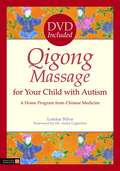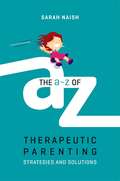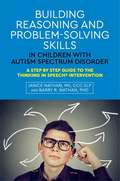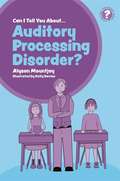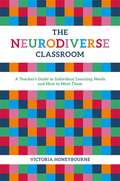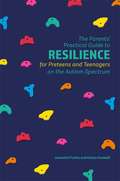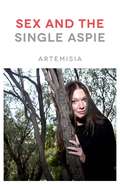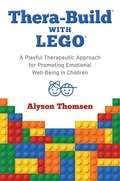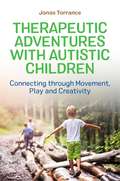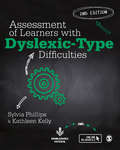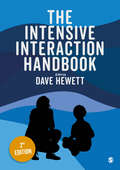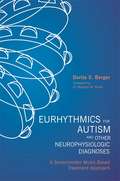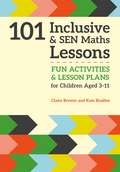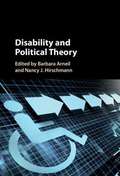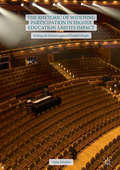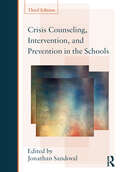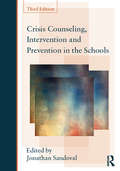- Table View
- List View
Qigong Massage for Your Child with Autism: A Home Program from Chinese Medicine
by Anita Cignolini Louisa SilvaQigong massage has been used in China for thousands of years as a means to achieve health and wellbeing, and to treat a wide variety of ailments. This book teaches parents a simple qigong massage programme that has been developed specifically for the needs of children with autism spectrum disorders (ASDs). With step-by-step instructions and an accompanying online content demonstrating the technique in action, this book offers parents clear guidance on how to adopt qigong massage into their child's daily routine successfully. The program is based around a core 15 minute massage that, when performed regularly, has been shown to greatly improve mood and behavior, sleeping patterns, and language and social skills. Also included is information on diet, advice on reading a child's body language during massage, and helpful progress checklists. Qigong massage is the ideal therapy for parents looking for an alternative way to strengthen the mind, body and sensory abilities of their young child with autism aged 6 and under.
Qigong Massage for Your Child with Autism (PDF): A Home Program from Chinese Medicine
by Anita Cignolini Louisa SilvaQigong massage has been used in China for thousands of years as a means to achieve health and wellbeing, and to treat a wide variety of ailments. This book teaches parents a simple qigong massage programme that has been developed specifically for the needs of children with autism spectrum disorders (ASDs). With step-by-step instructions and an accompanying online content demonstrating the technique in action, this book offers parents clear guidance on how to adopt qigong massage into their child's daily routine successfully. The program is based around a core 15 minute massage that, when performed regularly, has been shown to greatly improve mood and behavior, sleeping patterns, and language and social skills. Also included is information on diet, advice on reading a child's body language during massage, and helpful progress checklists. Qigong massage is the ideal therapy for parents looking for an alternative way to strengthen the mind, body and sensory abilities of their young child with autism aged 6 and under.
The A-Z of Therapeutic Parenting: Strategies and Solutions (Therapeutic Parenting Bks.)
by Sarah NaishTherapeutic parenting is a deeply nurturing parenting style, and is especially effective for children with attachment difficulties, or who experienced childhood trauma. This book provides everything you need to know in order to be able to effectively therapeutically parent. Providing a model of intervention, The A-Z of Therapeutic Parenting gives parents or caregivers an easy to follow process to use when responding to issues with their children. The following A-Z covers 60 common problems parents face, from acting aggressively to difficulties with sleep, with advice on what might trigger these issues, and how to respond. Easy to navigate and written in a straightforward style, this book is a 'must have' for all therapeutic parents.
The A-Z of Therapeutic Parenting: Strategies and Solutions
by Sarah NaishTherapeutic parenting is a deeply nurturing parenting style, and is especially effective for children with attachment difficulties, or who experienced childhood trauma. This book provides everything you need to know in order to be able to effectively therapeutically parent. Providing a model of intervention, The A-Z of Therapeutic Parenting gives parents or caregivers an easy to follow process to use when responding to issues with their children. The following A-Z covers 60 common problems parents face, from acting aggressively to difficulties with sleep, with advice on what might trigger these issues, and how to respond. Easy to navigate and written in a straightforward style, this book is a 'must have' for all therapeutic parents.
Building Reasoning and Problem-Solving Skills in Children with Autism Spectrum Disorder: A Step by Step Guide to the Thinking In Speech® Intervention
by Janice NathanTeaching children with Autism Spectrum Disorder (ASD) to develop the 'inner voice' needed to solve problems, this book's innovative approach will help children reach logical and appropriate solutions to everyday problems. This book shows students and professionals how to formally teach key skills for reasoning and problem-solving that aren't usually explicitly taught, such as planning, pausing and reflecting and increasing emotional regulation. Focusing on the 'inner voice' - the dialogue that goes on inside our heads during every day routines - the authors explain how to help children with ASD solve problems independently. The book also shows how children can learn to cope with feelings of stress when confronted with difficult situations, whether getting stuck on homework, making mistakes, choosing options, following procedures that are perceived to be arbitrary, or everyday social situations. Examples of implementing this new approach in different situations are given to show the many ways of teaching these cognitive skills to children with autism.
Can I tell you about Auditory Processing Disorder?: A Guide for Friends, Family and Professionals (Can I tell you about...?)
by Alyson Mountjoy Kelly DaviesIn this friendly guide, a girl called Amy tells all about her Auditory Processing Disorder (APD). Together with her friend Tom and sister Lucy, Amy explains how every child with APD is affected in unique ways, and how to get help if you have APD. This illustrated guide is ideal for helping children aged 7+ with APD to understand the condition, while increasing their self-esteem and confidence. Explaining about causes, symptoms, diagnosis and comorbidity in child-friendly terms, it dispels myths and encourages children to self-advocate and seek help at home and at school. It is also an excellent starting point for parents, teachers and other professionals wishing to tailor support to the type and severity of a child's APD, and includes a helpful list of recommended sources for additional support.
The Neurodiverse Classroom: A Teacher's Guide to Individual Learning Needs and How to Meet Them
by Victoria HoneybourneWith specific learning difficulties more prevalent than ever in mainstream schools, this is the essential guide for teachers wishing to create inclusive and successful learning environments in diverse classrooms. Focusing on promoting acceptance and self-esteem of each child rather than on labelling their difficulties, it shows how to make good use of simple resources and meet a wide range of needs, including children with ADHD, autism, OCD, dyslexia and special speech and language needs. The practical advice and strategies in this book enable schools to become more accepting places for all pupils, and embrace neurodiversity as the new 'normal' in education today.
The Parents’ Practical Guide to Resilience for Preteens and Teenagers on the Autism Spectrum
by Jeanette Purkis Emma GoodallThis book empowers parents of autistic young people aged 11 to 20 to help them promote resilience in their child. Full of suggestions and simple activities, this easy-to-use resource will help guide parents on how to build the foundations of resilience and independence for situations such as negotiating sexuality and relationships, entering employment or living away from home. It includes information about the main developmental stages for preteens and teens on the autism spectrum, and will take parents through life events and milestones at different ages and identify where difficulties and barriers to resilience may arise and how to address them.
Sex and the Single Aspie
by ArtemisiaThis ground-breaking book about sexuality speaks to women on the autism spectrum in fresh new ways, opening doors to discussion, and blowing the lid off taboo subjects. One of the many problems women on the spectrum face is not always understanding how relationships and boundaries work for other people. This book provides answers, plus more that they may not even have thought to ask. Covering one night stands, the importance of safe sex, self-respect, and double standards, there is a wealth of information about the ethics and self-understanding involved in relationships. Written with humour and honesty, this is the go-to guide for sex on the spectrum.
Thera-Build® with LEGO®: A Playful Therapeutic Approach for Promoting Emotional Well-Being in Children
by Alyson Thomsen'Thera-Build' is a LEGO®-based therapeutic approach for improving children's emotional well-being. Participation in Thera-Build groups can help to boost self-esteem, address common issues such as anxiety and anger, support social development and build positive attachments. This inspiring and user-friendly guide explores the power of play, introduces the basics of brain plasticity and attachment theory, and shows exactly how to set up and run an effective Thera-Build group. A wide range of imaginative games and activities is included.
Therapeutic Adventures with Autistic Children: Connecting through Movement, Play and Creativity
by Jonas TorranceA vivid exploration of working with autistic children using empowering techniques from a range of creative therapies. Each chapter in this heartening book is the story of a child with autism and how therapy was pivotal in confronting his or her individual dilemma. Covering many of the behaviours characteristic to autism, such as uncontrolled anger and obsessive tendencies, the therapies used range from drawing and dancing to meditation and martial arts, depending on the needs and interests of each child. The key message is that investing in the relationship between the therapist and the child - so that they grow, play and develop together - is transformative.
Studying With Dyslexia (Pocket Study Skills Ser. (PDF))
by Janet GodwinFull of practical advice and visual examples, this compact book provides learners with the tools and knowledge to work with their dyslexia. The book’s accessible layout and engaging style supports students with dyslexia and enables them to take control of their studies and learn in ways that are most effective for them. It covers all the core study skills, including reading, writing and revision, and includes guidance on how to manage time effectively. This is an ideal resource for students of all levels who want advice on how to manage their dyslexia in a positive way.
Assessment of Learners with Dyslexic-Type Difficulties
by Sylvia Phillips Dr Kathleen S. KellyReinforcing best practice techniques, the second edition of this specialist guide for the assessment of learners with dyslexic-type difficulties includes: - a new chapter on The Implications of Co-existing Specific Learning Difficulties - updates to legislation including the SEND Code of Practice - updates to specific diagnostic tests - examples of interpreting test profiles - photocopiable resources available to download from the website This comprehensive guide enables teachers to understand a range of approaches to the assessment of children with dyslexic-type difficulties. It is an essential companion for those training to be specialist teachers of learners with dyslexia and a useful resource for all SENCOs, and teachers new or experienced.
Assessment of Learners with Dyslexic-Type Difficulties
by Sylvia Phillips Dr Kathleen S. KellyReinforcing best practice techniques, the second edition of this specialist guide for the assessment of learners with dyslexic-type difficulties includes: - a new chapter on The Implications of Co-existing Specific Learning Difficulties - updates to legislation including the SEND Code of Practice - updates to specific diagnostic tests - examples of interpreting test profiles - photocopiable resources available to download from the website This comprehensive guide enables teachers to understand a range of approaches to the assessment of children with dyslexic-type difficulties. It is an essential companion for those training to be specialist teachers of learners with dyslexia and a useful resource for all SENCOs, and teachers new or experienced.
The Intensive Interaction Handbook
by Dave HewettThe only guide you need to read on the Intensive Interaction approach returns for its second edition, this time with its founder, Dave Hewett, as the Editor. The Intensive Interaction approach has spread around the world and has been hugely influential in developing and teaching communication techniques with individuals who have severe learning difficulties and autism. This straightforward, no-nonsense handbook contains: - 2 new chapters: The Intensive Interaction Outcomes Reporter; and Autism and Intensive & Intensive Interaction and more able people; - photo stories demonstrating the approach in practice; - links to external videos presenting the photo stories in greater depth. More information on the Intensive Interaction community and approach can be found on dedicated social media pages, and at https://www.intensiveinteraction.org/
Eurhythmics for Autism and Other Neurophysiologic Diagnoses: A Sensorimotor Music-Based Treatment Approach
by Stephen M. Shore Dorita S. BergerIn Eurhythmics for Autism and Other Neurophysiologic Diagnoses, Dorita S. Berger reveals how Eurhythmics, a method of teaching the musical concepts of rhythm, structure and expression kinaesthetically through movement, can help develop sensorimotor skills in children and adults with autism and other special needs. Covering both theory and practice, she explains this innovative, music-based approach and how it can also address cognitive and sensory issues in adults with debilitating conditions, such as dementia or post-traumatic stress disorder. With a particular emphasis on autism, she provides clear and adaptable session plans, suitable for working with children and adults of all ages.
Eurhythmics for Autism and Other Neurophysiologic Diagnoses (PDF): A Sensorimotor Music-Based Treatment Approach
by Stephen M. Shore Dorita S. BergerIn Eurhythmics for Autism and Other Neurophysiologic Diagnoses, Dorita S. Berger reveals how Eurhythmics, a method of teaching the musical concepts of rhythm, structure and expression kinaesthetically through movement, can help develop sensorimotor skills in children and adults with autism and other special needs. Covering both theory and practice, she explains this innovative, music-based approach and how it can also address cognitive and sensory issues in adults with debilitating conditions, such as dementia or post-traumatic stress disorder. With a particular emphasis on autism, she provides clear and adaptable session plans, suitable for working with children and adults of all ages.
101 Inclusive and SEN Maths Lessons: Fun Activities and Lesson Plans for Children Aged 3 – 11 (101 Inclusive And Sen Lessons Ser.)
by Claire Brewer Kate BradleyCreate an inclusive classroom for all through engaging maths activities such as Shape Bingo, Cake Splat! and Fruity Fractions, all of which have been matched to the UK National Curriculum P Levels 4 - 8. Tailored to the specific P Level, each lesson plan includes a learning objective, the resources needed, the main activity, a plenary and a consolidation activity to help support children's understanding. When working with children, and especially those with SEN, lessons need to meet their interests as well as their needs by containing visual stimulus, movement and fine and gross motor skills, and the activities in this book have been specifically designed with this in mind. This straightforward and practical book offers you 101 creative classroom activities for teaching maths to pupils who are achieving at P Levels 4 - 8 and Key Stage One as well as mapping the range of additional skills they will acquire.
101 Inclusive and SEN Maths Lessons (PDF): Fun Activities and Lesson Plans for Children Aged 3 – 11
by Claire Brewer Kate BradleyCreate an inclusive classroom for all through engaging maths activities such as Shape Bingo, Cake Splat! and Fruity Fractions, all of which have been matched to the UK National Curriculum P Levels 4 - 8. Tailored to the specific P Level, each lesson plan includes a learning objective, the resources needed, the main activity, a plenary and a consolidation activity to help support children's understanding. When working with children, and especially those with SEN, lessons need to meet their interests as well as their needs by containing visual stimulus, movement and fine and gross motor skills, and the activities in this book have been specifically designed with this in mind. This straightforward and practical book offers you 101 creative classroom activities for teaching maths to pupils who are achieving at P Levels 4 - 8 and Key Stage One as well as mapping the range of additional skills they will acquire.
Disability and Political Theory (PDF)
by Edited by Barbara Arneil Nancy J. HirschmannThough disability scholarship has been robust in history, philosophy, English, and sociology for decades, political theory and political science more generally have been slow to catch up. This groundbreaking volume presents the first full-length book on political theory approaches to disability issues. Barbara Arneil and Nancy J. Hirschmann bring together some of the leading scholars in political theory to provide a historical analysis of disability through the works of canonical figures, ranging from Hobbes and Locke to Kant, Rawls and Arendt, as well as an analysis of disability in contemporary political theory, examining key concepts, such as freedom, power and justice. Disability and Political Theory introduces a new disciplinary framework to disability studies, and provides a comprehensive introduction to a new topic of political theory.
The Rhetoric of Widening Participation in Higher Education and its Impact: Ending the Barriers against Disabled People
by Navin KikabhaiThis book offers a critical investigation of the exclusion of individuals described as having ‘learning difficulties’ from participation in higher education. Using a postmodernist framework, the author explores the insights and experiences of a theatre group attempting to develop an undergraduate degree programme in the performing arts. In doing so, he provides a theoretical map of insights into discourses of power and knowledge, and makes transparent competing and contradictory discursive practices. Suggesting that ‘learning difficulties’ is a constructed and re-constructed discourse serving normative interests, the author demonstrates that despite the rhetoric of widening participation, individuals are intentionally beset by barriers, silenced and excluded from degree level participation. The author calls for a radical re-think of the notion of ‘learning difficulties’, segregated provision, access to employment in theatre, and critically questions the notion of participation in higher education. This pioneering volume will appeal to students and scholars of inclusive education, (critical) disability studies, cultural studies and the sociology of education.
The Rhetoric of Widening Participation in Higher Education and its Impact: Ending the Barriers against Disabled People
by Navin KikabhaiThis book offers a critical investigation of the exclusion of individuals described as having ‘learning difficulties’ from participation in higher education. Using a postmodernist framework, the author explores the insights and experiences of a theatre group attempting to develop an undergraduate degree programme in the performing arts. In doing so, he provides a theoretical map of insights into discourses of power and knowledge, and makes transparent competing and contradictory discursive practices. Suggesting that ‘learning difficulties’ is a constructed and re-constructed discourse serving normative interests, the author demonstrates that despite the rhetoric of widening participation, individuals are intentionally beset by barriers, silenced and excluded from degree level participation. The author calls for a radical re-think of the notion of ‘learning difficulties’, segregated provision, access to employment in theatre, and critically questions the notion of participation in higher education. This pioneering volume will appeal to students and scholars of inclusive education, (critical) disability studies, cultural studies and the sociology of education.
Crisis Counseling, Intervention and Prevention in the Schools (Consultation, Supervision, and Professional Learning in School Psychology Series)
by Jonathan SandovalSince the first edition was published in 1988, the role of crisis intervention and prevention has become central to mental health professionals working in the schools. Disasters such as hurricane Katrina, terrorist attacks both in this country and around the world, and various school shootings have greatly increased school crisis research and policy development. This book is designed for an introductory graduate course taken by students in school psychology, school counseling, and school social work. Section I provides a crisis response overview, section II deals with crises for children and adolescents and section III covers crises that manifest in adolescence. Discussions of the 16 most prevalent types of crises are covered in sections II and III and include their characteristics, causes, interventions, and preventive programs. All chapters will be updated, six heavily revised or totally rewritten by new authors, and two new chapters (chapters 8 & 19) have been added.
Crisis Counseling, Intervention and Prevention in the Schools (Consultation, Supervision, and Professional Learning in School Psychology Series)
by Jonathan SandovalSince the first edition was published in 1988, the role of crisis intervention and prevention has become central to mental health professionals working in the schools. Disasters such as hurricane Katrina, terrorist attacks both in this country and around the world, and various school shootings have greatly increased school crisis research and policy development. This book is designed for an introductory graduate course taken by students in school psychology, school counseling, and school social work. Section I provides a crisis response overview, section II deals with crises for children and adolescents and section III covers crises that manifest in adolescence. Discussions of the 16 most prevalent types of crises are covered in sections II and III and include their characteristics, causes, interventions, and preventive programs. All chapters will be updated, six heavily revised or totally rewritten by new authors, and two new chapters (chapters 8 & 19) have been added.
